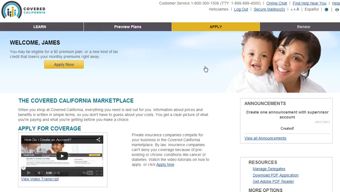Applying for health insurance under the government’s Affordable Care Act won’t be quick or easy, to no one’s surprise.
In fact, filling out the required forms may feel like a rerun of April 15. And, yes, the IRS will be peeking in to make sure we’re not fibbing about income if seeking government subsidies.
California application preview
 Covered California, the state health insurance marketplace, premiered its online application process just before the service went live in early October 2013.
Covered California, the state health insurance marketplace, premiered its online application process just before the service went live in early October 2013.
The online application requires moving through something like 70 web pages, most of them brief. (Consumers can choose to apply offline, via a fairly thick packet of documents.)
To gain entry online, insurance shoppers will have to establish an account, with the usual username, password and PIN. (The electronic PIN will be needed to submit the application.) There is a set-up process for several security questions (such as mother’s maiden name).
For assistance, the web site offers online chat. Help also is available by calling (800) 300-1506.
Covered California said the online application will take about 30 minutes, but the number of household members will have a big effect on total time.
Those seeking subsidies should be prepared have to submit detailed income and tax return information. Those who know they can’t qualify for financial help can move ahead to a section where they can “purchase an affordable” health insurance plan.
The health marketplace suggests applicants have the following at hand:
- Contact info
- Info about household members
- Latest tax information
- Current income information
After the information is submitted, a screen offers eligibility results. At that point, consumers can shop for health insurance.
The shopping section asks for medical information in order to estimate annual costs (insurers cannot use health background to determine premiums). Shoppers can look to see if specific doctors are participating in any of the networks offered.
The application also explains options for receiving tax subsidies in advance. The system also facilitates the purchase of (separate) pediatric dental insurance plans.
Federal application preview
Earlier in the Obamacare launch process, the federal government released to health and insurance professionals a 21-page draft of its application. It has two functions, in fact, as described in the page 1 title show below:
Here’s a sneak preview, based on the materials posted online by the Department of Health & Human Services. (The application was later simplified.)
How long will it take? Looks like a half hour for singles; an hour or two for families, assuming all the information is at hand. A copy of the most recent tax return will be a big help.
There’s a questionnaire for each person in the family, so singles will be getting through the process a lot quicker. Domestic partners are in the mix as well.
“Why do we ask for so much information?” the draft application asks itself on the first page. Answer: “To make sure you and your family get the most benefits possible.”
You’ll be able to apply online, or on paper. If you apply online, apparently your verification of income and citizenship will be immediate. If you mail in the application, the response is supposed to come in one or two weeks.
Of course, applying for health insurance was never simple. Dealing with the government may, in fact, be an upgrade over dealing with balky and suspicious insurance companies.
Your medical history won’t be in the mix. That’s one huge change. You won’t be detailing your medical condition because, basically, it doesn’t matter. Insurers have to take you — and take you at the same rate as others of your age and sex.
Help will be available for those baffled by bureaucratic paperwork, or just by this form. Assistance should come online, on the phone and in person at local centers. The state health marketplace (exchange) Covered California says the help will be available “later this year.” There’s a place on the form for people providing assistance (“navigators”) to identify themselves.
Income information is requested for all family members. The form asks about income “before taxes,” so qualification appears based on gross income. It does not ask about tax deductions. It tells applicants to break out “other income” such as capital gains and dividends — but not child support.
For the self-employed, the form asks about net income. It includes a list of allowable deductions of the type used for federal taxes. They include rent for business purposes, advertising, some business travel and vehicle expenses.
If you had health insurance but lost it — making you eligible for the health exchange — the form wants to know why you are no longer insured. For the family, it asks if anyone gets health insurance via a job.
If your employer offers insurance, the form wants to know about the lowest-cost “self only” health plan available. It asks, oddly, “Do you think the employer’s coverage is affordable?” Plans have to meet the “minimum value standard” set by the Affordable Care Act, so be prepared to check the “Don’t know” box on that question.
The last section of the application concerns on-the-job coverage options and is filled out in part by your employer.
Immigration status information is required for those who aren’t citizens but are in the country legally.
If you’re a Native American (exempt from the penalty for not having insurance), the form wants to know that as well. In fact, some of the questions bring to mind the Census — such as if you’re Hispanic/Latino, which kind? (Mexican, Puerto Rican, etc.)
The government says it’s making changes in the application form based on feedback from the health and insurance professionals, so some of the above may change.

Recent Comments